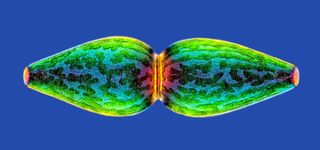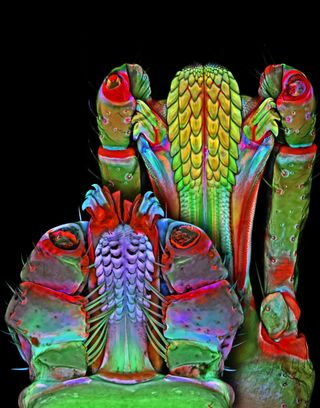Tiny Creatures Come to Life in 'Small Worlds' Photo Contest
Without access to a microscope or a sophisticated zoom lens, most people don't get to see plant pores and cricket tongues up close. But the entrants in the 2014 Nikon Small World photography contest offer an intimate look at tiny realms rarely seen outside of a lab. The judges of the annual contest will reveal their top picks on Oct. 30, but the following images are a sample of the submissions. More information can be found on the contest website.

This isn't a glow-in-the-dark gingko leaf. It's actually the tongue of a house cricket (Acheta domesticus). (Credit: Stefano Barone, Cremona, Italy)

The Tradescantia zebrina species of wandering Jew is beloved for its zebra-patterned leaves and bright flowers. But up close, the tiny pores that let the plant "breathe" are lovely in their own right. (Credit: Jerzy Gubernator, Faculty of Biotechnology, University of Wroclaw, Poland)

Apparently some bacteria look like hot lava when they tunnel through calcite. (Credit: Brandon Guida, School Of Life Sciences, Arizona State University)

Dryhead agate found in Montana is prized for its richly colored bands. Here's what a rock from the deposit looks like at 50-times magnification. (Credit: Douglas Moore, University Relations and Communications, University of Wisconsin - Stevens Point)

A festive holiday light or micro algae? (Credit: Rogelio Moreno, Panama)

What's the secret of this scarlet pimpernel? A stunning tower of pollen. (Credit: Jens H. Petersen, MycoKey, Ebeltoft, Denmark)
Sign up for the Live Science daily newsletter now
Get the world’s most fascinating discoveries delivered straight to your inbox.

Maybe this is the "American Gothic" of ticks. But there are no pitchforks, just mouthparts, on display here in this portrait of a brown dog tick and lone star tick. (Credit: Igor Robert Siwanowicz, Janelia Farm Research Campus, Howard Hughes Medical Institute (HHMI), Ashburn, Virginia)

The Eupholus genus has the most colorful little weevils. (Credit: Luca Toledano, Zoology, Museo Civico di Storia Naturale di Verona, Italy)

You might think leafy liverworts were taking their cues from Tiffany lamps. This isn't stained glass, but a berberine-stained gametophyte of the Nowellia curvifolia species. (Credit: Magdalena Turzanska, Institute of Experimental Biology, University of Wroclaw, Poland)

No surprises here. This really is a starfish — albeit a very young and very tiny one, shown at five-times magnification. (Credit: Steven Wilbert, Confocal Microscopy Lab, Rochester Institute of Technology, Rochester, New York)

Magnesium chloride and potassium alum might be the real the artists here. (Credit: Chao Zhang, National Astronomical Observatories, Chinese Academy of Sciences, Beijing)
Follow Megan Gannon on Twitter and Google+. Follow us @livescience, Facebook & Google+. Original article on Live Science.



